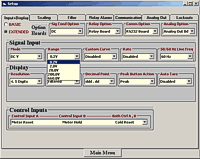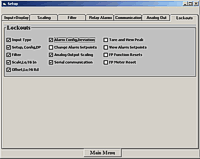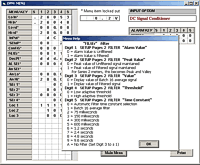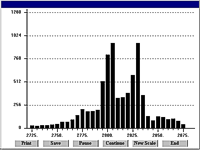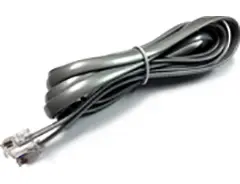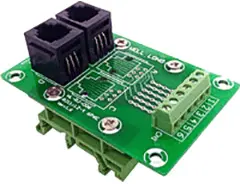Features
- Times periodic events with width from 1 µs to 199.999 s
- Transmits average time of periodic events with width from 1 µs to 199.999 s
- Resolution to 0.2 µs, rep rated to 250 kHz
- Inputs from NPN or PNP proximity switches, contact closures, digital
logic, magnetic pickups down to 12 mV, or AC inputs up to 250 Vac - Trigger on positive or negative pulse edges
- Digital span adjust from 0 to ±999,999, zero adjust from -999,999 to +999,999
- Front panel scalable: to ±999,999 for use with current shunts
- 1/8 DIN size with bright red or green 0.56" (14.2mm), high LED digits
- Transducer excitation output, 5, 10, 12, or 24 Vdc (isolated)
- Power 85-264 Vac / 90-300 Vdc or 10-48 Vdc / 12-32 Vac (isolated)
- Operating temperature from -40°C to 70°C (-40°F to 158°F)
- Wide choice of Plug-in-Play options:
- 2 or 4 relays, mechanical or solid state, for alarm or control (isolated)
- 1 or 2 Analog output, 4-20 mA, 0-20 mA, 0-10V, or -10V to +10V (isolated)
- Communications: Ethernet, WiFi, USB, RS232, RS485 (isolated)
- Extended DPM includes rate and total simultaneously, dynamic up-down counting, arithmetic functions
Certificates of Compliance

The Laureate™ 1/8 DIN Digital Panel Meters for A-to-B Time Interval
can display pulse width or time delay between individual pulses to a resolution of 0.2 µs. It can also display average pulse width or average time delay between multiple pulses.Time interval is measured between inputs on channels A and B. Timing starts when a pulse is applied to Channel A (selectable positive or negative edge), and ends when a pulse is applied to Channel B (selectable positive or negative edge). In case of a single pulsed signal, the A and B inputs can be tied together. A positive or negative slope may be selected to start timing, and the opposite slope must be selected to stop timing. Timing is achieved by counting 5.5 MHz clock pulses. Multiple integral time intervals are averaged over a gate time which is selectable from 10 ms to 199.99 s and also controls the display update time.
Time interval can be displayed in seconds, milliseconds, or microseconds with 6-digit resolution. In the typical application, time is displayed in milliseconds with 1 µs resolution. For times less than 100 ms, display resolution down to 0.2 µs can be achieved by applying a multiplier of 10, moving the decimal point by one position, and averaging many time intervals.
Highly accurate rate can be displayed by taking the inverse of time. Extensive arithmetic capabilities allow display in engineering units, such as meters/sec. An Extended main board version offers all features of Standard main board plus rate based on 1/time.
The FR dual-channel signal conditioner board accepts inputs from proximity switches with a PNP or NPN output, TTL or CMOS logic, magnetic pickups, contact closures, and other signals from 12 mV to 250 Vac. Jumper selections provide optimum operation for different sensor types and noise conditions. A built-in (isolated) 5, 10, 12, or 24 Vdc excitation supply can power proximity switches and other sensors, and eliminate the need for an external power supply.
Extended DPM includes rate and total simultaneously, dynamic up-down counting, arithmetic functions applicable to channels A & B (A+B, A-B, A/B, AxB, A/B-1), phase angle, power factor, duty cycle, batch control, custom curve linearization.
Laureate Digital Panel Meters are easily programmed with Laurel’s free Instrument Setup Software, downloadable from our website and compatible with Windows PCs, requiring a data interface board for setup.
All signal conditioner board ranges are factory-calibrated, with calibration factors for each range securely stored in an onboard EEPROM. These factors can be scaled via software to accommodate external shunts, enabling field replacement of signal conditioner boards without necessitating recalibration of the associated digital panel meters. For optimal accuracy, factory recalibration is recommended annually. All Laurel Electronics instruments undergo factory calibration using the industry-leading Fluke calibrators, which are recalibrated yearly and certified traceable to national standards, ensuring the highest level of precision and reliability.
- An unfiltered selection provides true peak and valley readings and aids in control applications.
- A batch average filter selection averages each 16 conversions.
- An adaptive moving average filter selection provides a choice of 8 time constants from 80 ms to 9.6 seconds. When a significant change in signal level occurs, the filter adapts by briefly switching to the shortest time to follow the change, then reverts back to its selected time constant. An Auto setting selects the time constant selection based on signal noise.
Peak and valley values are automatically captured. These may be displayed via a front panel pushbutton command or control signal at the rear connector, or be transmitted as serial data.
Two rear panel control Inputs (CMOS/TTL levels, logic 0 = tied to digital ground, logic 1 = open) or dry contacts that can be set to control / activate 14 meter commands.
An (isolated) 5, 10, 12, or 24 Vdc excitation output is standard to power transducers or two-wire transmitters. Ratiometric operation, which automatically compensates for changes in the applied excitation, is jumper selectable for applications, such as bridges, where the signal to be measured is proportional to the excitation level.
Modular Design for Maximum Flexibility at Minimum Cost
All boards are isolated from meter and power grounds. Optional Plug-in-Play boards for communications and control include Ethernet, WiFi, serial communication boards, dual or quad relay boards, and an analog output board. Laureates may be powered from 85-264 Vac or optionally from 12-32 Vac or 10-48 Vdc. The display is available with bright red or green 0.56" (14.2mm) high LED digits. The 1/8 DIN case meets NEMA 4X (IP65) specifications from the front when panel mounted. Any setup functions and front panel keys can be locked out for simplified usage and security. A built-in 5, 10, 12, or 24 Vdc excitation supply can power transducers, eliminating the need for an external power supply. All power and signal connections are via UL / VDE / CSA rated screw clamp plugs.
The Laureate™ Series features modular design with up to 7 isolated plug-in boards, applicable to all Laureate 1/8 DIN Digital Panel Meters.

Modular Hardware
The design of the Laureate™ Series is modular for maximum flexibility at minimum cost. All boards are isolated from meter and power grounds. The base configuration for a panel meter or counter consists of a main module (with computer and plug-in display boards), a power supply board, and a signal conditioner board. Optional plug-in-play boards include an isolated setpoint controller board, an isolated analog output board, and an isolated digital interface board. Modular design and a choice of plug-in options allow the Laureate to be customized for a broad range of applications from simple monitoring to control and computer interface. There can be up to five plug-in boards in a 1/8 DIN Laureate.

Connecting Laureate Digital Panel Meters to a Local Area Network (LAN)
Up to 30 Laureate Digital Panel Meters and/or LT Transmitters can be configured for RS485 and daisy-chained to an LT Transmitter using Laurel’s High Speed Ethernet-to-RS485 converter board for seamless LAN integration. Alternatively, Laurel LTE series Ethernet transmitters can connect directly to a LAN via an Ethernet cable. Setup for both configurations is streamlined using Laurel’s free Instrument Setup Software, which simplifies node discovery and transmitter configuration.
Flexible Communication Options for Digital Panel Meters
Laureate Digital Panel Meters can be equipped with Laurel communication boards to support various interfaces and protocols. These include serial interfaces with ASCII or Modbus RTU protocols, and Ethernet interfaces with web access, ASCII, or Modbus TCP/IP protocols, ensuring versatile connectivity for your commercial applications.

| Display | |
|---|---|
| Readout | 6 LED digits, 7-segment, 14.2 mm (.56"), red or green. |
| Range | -999,999 to +999,999 |
| Indicators | Four LED lamps |
| Inputs | |
| Types | AC, pulses from NPN, PNP transistors, contact closures, magnetic pickups. |
| Signal Ground | Common ground for channels A & B |
| Channel A Freq. | 0 Hz to 1 MHz |
| Channel B Freq. | 0 Hz to 250 kHz |
| Minimum Signal | Nine ranges from (-12 to +12 mV) to (+1.25 to +2.1V). |
| Maximum Signal | 250 Vac |
| Noise Filter | 1 MHz, 30 kHz, 250 Hz (selectable) |
| Recalibration: All ranges are calibrated at the factory. Recalibration is recommended every 12 months. | |
| Time Interval Mode | |
| Timing Start | Channel A pulse, + or - edges |
| Timing Stop | Channel B pulse, + or - edges |
| Periodic Timing Interval | Gate time + 30 ms + 0-2 time intervals |
| Gate Time | Selectable 10 ms to 199.99 s |
| Time Before Zero Output | Selectable 10 ms to 199.99 s |
| Resolution | |
| 0 - 199.999 s | 1 ms |
| 0 - 99.9999 s | 100µs |
| 0 - 9.99999 s | 10 µs |
| 0 - .999999 s | 1 µs |
| 0 - .099999 s | 0.2 µs |
| Accuracy | |
| Time Base | Crystal calibrated to ±2 ppm |
| Span Tempco | ±1 ppm/°C (typ) |
| Long-term Drift | ±5 ppm/year |
| Maximum Signal | |
| Max applied voltage | 600 Vac for 20, 200 and 300 V ranges, 125 Vac for other ranges |
| Overcurrent protection |
25x for 2 mA, 8x for 20 mA, 2.5x for 200 mA, 1x for 5 A |
| Power Supply Boards (one required) | |
| Voltage, standard | 85-264 Vac or 90-300 Vdc |
| Voltage, optional | 12-32 Vac or 10-48 Vdc |
| Frequency | DC or 47-63 Hz |
| Power consumption | 1.2W @ 120 Vac, 1.5W @ 240 Vac, 1.3W @ 10 Vdc, 1.4W @ 20 Vdc, 1.55W @ 30 Vdc, 1.8W @ 40 Vdc, 2.15W @ 48 Vdc (typical, base meter) |
| Power Isolation | 250V rms working, 2.3 kV rms per 1 min test |
| Excitation Output (standard) | |
| 5 Vdc | 5 Vdc ± 5%, 100 mA (jumper selectable) |
| 10 Vdc | 10 Vdc ± 5%, 120 mA (jumper selectable) |
| 12 Vdc | 12 Vdc ± 5%, 100 mA (jumper selectable) |
| 24 Vdc | 24 Vdc ± 5%, 50 mA (jumper selectable) |
| Output Isolation | 50 Vdc from signal ground |
| Analog Output Boards (one optional) | |
| Output levels | 4-20 mA, 0-20 mA, 0-10V, -10 to +10V (jumper selectable) |
| 4-20 mA, 0-20 mA, 0-10V (dual-output option) | |
| Current compliance | 2 mA at 10V ( > 5 kΩ load) |
| Voltage compliance | 12V at 20 mA (< 600 Ω load) |
| Scaling | Zero and full scale adjustable from -99999 to +99999 |
| Resolution | 16 bits (0.0015% of full scale) |
| Isolation | 250V rms working, 2.3 kV rms per 1 min test |
| Relay Output Boards (one optional) | |
| Dual magnetic relays | 2 Form C, 10A max, 440Vac or 125Vdc max, 2500VA or 300W |
| Quad magnetic relays | 4 Form A (NO), 10A max, 440Vac or 125Vdc max, 2500VA or 300W |
| Dual solid state relays | 2 Form A (NO), AC or DC, 0V - 400V, 120Ma, 35Ohms (max at On-State) |
| Quad solid state relays | 4 Form A (NO), AC or DC, 0V - 400V, 120Ma, 35Ohms (max at On-State) |
| Relay commons | Isolated commons for dual relays or each pair of quad relays |
| Relay isolation | 250V rms working, 2.3 kV rms per 1 minute test |
| Relay latching modes | Latching or non-latching |
| Relay active modes | Active on or off, active high or low |
| Hysteresis modes | QA passband mode, split hysteresis, span hysteresis |
| Communication Boards (one optional) | |
| Board selections | RS232, RS485 with dual RJ11 connectors, RS485 with dual RJ45 connectors, USB, Ethernet, USB-to-RS485 gateway, Ethernet-to-RS485 gateway, WiFi with built-in antenna plus USB & RS485, WiFi with external antenna plus USB & RS485 |
| Protocols | Laurel Custom ASCII (serial), Modbus RTU (serial), Modbus TCP (Ethernet or WiFi) |
| Digital addresses | 247 (Modbus), 31 (Laurel ASCII), |
| Isolation | 250V rms working, 2.3 kV rms per 1 min test |
| Environmental | |
| Operating temperature | -40°C to 70°C (-40°F to 158°F) |
| Storage temperature. | -40°C to 85°C (-40°F to 185°F) |
| Relative humidity | 95% at 40°C, non-condensing |
| Protection | NEMA-4X (IP-65) when panel mounted |
| Signal Connections | |
 |
|
| Mechanical | |
| Enclosure | 1/8 DIN, high impact plastic, UL 94V-0, color: black |
| Mounting | 1/8 DIN panel cutout required: 3.622" x 1.772" (92 mm x 45 mm). |
| Dimensions | 4.68" x 2.45" x 5.64" (119 mm x 62 mm x 143 mm) (W x H x D) |
| Maximum panel thickness | 4.5 mm (0.18") |
| Tightening Torque - Connectors | Screw terminal connectors: 5 lb-in (0.56 Nm) |
| Tightening Torque - Pawls | Digital Panel Meter Case Pawls: 5 lb-in (0.56 Nm) |
| Weight of base meter | 210 g (7.4 oz) typical (DPM, counter, timer, 6-digit remote display) |
| Weight of option boards | 30 g (1.0 oz) typical per board (analog output, relay output, communications) |
| General | |
| Programming Methods | Four front panel buttons or via Laurel's free Instrument Setup Software, which runs on a PC under MS Windows. |
| Security | Lockout options include using the front panel buttons, the free Instrument Setup Software, or a hardware jumper. |
| Warranty | 3 years parts & labor |
| Recalibration: All ranges are calibrated at the factory. Recalibration is recommended every 12 months. | |
Free Instrument Setup Software for Series 2 Laureates
Free Downloadable Windows-based Instrument Setup (IS) software (Data Interface Board Required) for use with our programmable Digital Panel Meters, Scale Meters, Counters, Timers, Remote Displays, and Transmitters, are an easy method to set up Laureate 1/8 DIN digital panel meters, counters, timers, remote displays, and DIN-rail transmitters, as explained in the Instrument Setup Software Manual. Laureate 1/8 DIN instruments can also be set up from the front panel, as explained in their respective Owners Manuals. Instrument Setup software is of benefit whether or not the PC is connected to the instrument.
- When the PC is connected to the instrument, Instrument Setup software can retrieve the setup file from the instrument or open a default setup file or previously saved setup file from disk View Setup, then provides graphical user interface (GUI) screens with pull-down menus applicable to input, display, scaling, filtering, alarms, communications, analog output, and front panel lockouts. Fields that are not applicable to the instrument as configured are either left out or grayed out. Clicking on any item will bring up a detailed Help screen for that item. After editing, the setup file can be downloaded, uploaded to the instrument, or saved to a disk. The same setup file can then be downloaded into multiple instruments.
- When the PC is not connected to the instrument, the above GUI screens can be used to set up a virtual instrument. The setup file can then be saved to disk. Switching toView Menu then brings up a screen with the required front panel programming steps. This view can be printed out for use at the instrument site and to serve as a hard copy record.
Download Free Instrument Setup Software
Installation
Set User Account Control (UAC) of MS Windows to "Never notifiy me" so that Instrument Setup Software can create directories. The UAC change screen can be reached as follows:
- Under Windows 7, click on the Windows Start button in the lower left of the desktop and enter "UAC" in the search field.
- Under Windows 8, navigate to Control Panel, then to the "User Accounts and Family Safety" section, and click on "Change User Account Control Settings."
- Under Windows 10, click on the Windows Start button in the lower left of the desktop, then on "Settings", and enter "UAC" in the search field.
- Reboot your computer for the changed UAC setting to take effect.

RJ11-to-DB9 cable with rear view of DB9 connector to PC

RS232 cable, meter to PC, P/N CBL01
Laureate 1/8 DIN Laureate instruments must be equipped with a serial communications board and be connected to the computer via a serial communications cable. The connection can be via RS232, RS485, USB or Ethernet. Following setup, the serial communications board may be removed from the instrument if desired. The wiring of the RS232 cable is illustrated above with end views of the two connectors.
Laureate LT Series transmitters come standard with a 3-wire serial interface, which can be jumpered for RS232 or RS485.
Laureate LTE Series transmitters come standard with an Ethernet interface.
Meter Setup Screens
Click on any of the reduced screens below for a full-size screen view, then click on the Back button of your browser to return to this page. The screens examples below are for a fully-loaded Series 2 Digital Panel Meter (DPM), which is connected to the PC via RS232. If the meter is a Series 1 meter (pre-2007), this is sensed by the software, and somewhat different screens are brought up. Please see Series 1 setup screens.











Meter Setup Utilities




From the Main Menu, click on Readings if your PC is connected to the meter. A pull-down menu then offers three choices: List, Plot and Graph.
- List presents the latest readings in a 20-row by 10-column table. Press Pause at any time to freeze the display. This is one method to capture peak readings.
- Plot generates a plot of readings vs. time in seconds. It effectively turns the DPM-PC combination into a printing digital oscilloscope.

- Graph generates a histogram where the horizontal axis is the reading and the vertical axis is the number of occurrences of readings. The display continually resizes itself as the number of readings increases.



Laureate™ 1/8 DIN Case For Laureate Digital Panel Meters, Counters, Timers & Remote Displays

Key Features
- Meets 1/8 DIN Standard.
- Installs from front of panel.
- Short depth behind the panel: only 4" (102 mm) plus connectors.
- Understated 0.157" (4 mm) thick bezel.
- Meets NEMA 4X (IP-65) for high-pressure wawshdon when panel mounted.
- Screw clamps connectors meet VDE / IEC / UL / CSA safety standards.
- Rugged GE Lexan® housing material.
- Safety certified per EN 61010-1.
Dimensions

Maximum panel thickness: 4.5 mm (0.18")
Weight of base meter: 210 g (7.4 oz) typical (DPM, counter, timer, 6-digit remote display)
Weight of option boards: 30 g (1.0 oz) typical per board (analog output, relay output, communications)
Tightening Torque - Connectors: Screw terminal connectors: 5 lb-in (0.56 Nm)
Tightening Torque - Pawls: Digital Panel Meter Case Pawls: 5 lb-in (0.56 Nm)
Dimensioned CAD assembly drawings in EPRT, STEP, x_t. dwg, pdf file formats: Laureate-meter-case.zip (zipping prevents browser from opening CAD files as text files).
Panel Mounting
 Slide the meter into a 45 x 92 mm 1/8 DIN panel cutout. Ensure that the provided gasket is in place between the front of the panel and the back of the meter bezel.
The meter is secured by two pawls, each held by a screw, as illustrated. Turning each screw counterclockwise extends the pawl outward from the case and behind the panel. Turning each screw clockwise further tightens it against the panel to secure the meter.
Slide the meter into a 45 x 92 mm 1/8 DIN panel cutout. Ensure that the provided gasket is in place between the front of the panel and the back of the meter bezel.
The meter is secured by two pawls, each held by a screw, as illustrated. Turning each screw counterclockwise extends the pawl outward from the case and behind the panel. Turning each screw clockwise further tightens it against the panel to secure the meter.
Turning each screw counterclockwise loosens the pawl and retracts it into its well. This position allows installed meter to be removed from their panel, or new meters to be installed in a panel. Do not remove the screws from their pawls. Doing so would cause the screw and pawl to fall off and likely get lost. Do not overtighten so as not to damage the plastic parts.
| Time Interval Mode for Time Delay | |
|---|---|
 |
For periodic pulses applied to A and B channels, time delays can be measured down to 0.2 µs resolution from the rising or falling edge of A to the rising or falling edge of B (selectable). |
| Time Interval Mode for Pulse Width | |
 |
The width of periodic pulses (t1 or t2) can be measured by tying the A and B channels together. As for time delay, readings are averaged over a user-selectable gate time. |
| Timing Process Dynamics with a Panel Meter and Time Interval Meter | |
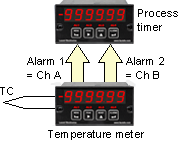 |
The start and stop pulses used for timing can be generated by the dual relay board in a Laureate panel meter or digital counter. For instance, the start and stop pulse edges can be created as temperature passes two alarm setpoints, or temperature cycles in a hysteresis control mode. |
| Rate Based on 1 / Time | |
 |
The Extended stopwatch meter can be programmed to display highly accurate rate based on elapsed time. A pulse or switch closure can initiate timing, while another pulse or switch closure stops timing. The meter can be programmed with multipliers to display rate in appropriate engineering units, such as meters/sec, for any time duration. |
| Replacing an Oscilloscope with a Laureate Time Interval Meter | |
 |
An oscilloscope is great for viewing and timing pulses in a lab. However, in fixed installations where digital timing accuracy and control outputs are required, a low-cost Laureate time interval meter will be the instrument of choice. Resolution to 0.2 µs is feasible. |
| Instrumenting a Pulsed Laser System Using Laureate Counters | |
 |
|
| Some of the many possibilities in instrumenting a pulsed laser system with Laureate dual-channel counters. | |
DLS-XLOG2
XLog2 Data logging Software
CON01
CON01 Connector
IPC
Splashproof Cover
CBL01
RS232 Cable for Meters
CBL02
USB-to-RS232 Adapter Cable
CBL04
RS232 Cable for LT Transmitters
CBL05
USB Data Cable for Meters
CBL06
USB-to-RS485 Adapter Cable
CBL07
USB Programming & Data Cable
CBL08
RS485 Splitter Cable
BKBD
RS485 RJ11 Terminal Block Adapter
Understanding 1/8 DIN Digital Panel Meters for Time Interval
In various industries and technical fields, precise measurement and monitoring are crucial. One of the specialized instruments used for this purpose are the 1/8 DIN Digital Panel Meters for Time Interval. This compact yet powerful device plays a key role in measuring and displaying time intervals with high accuracy. Here’s a detailed look at what makes these digital panel meters essential and how they work.
What are 1/8 DIN Digital Panel Meters?
1/8 DIN Digital Panel Meters are a type of electronic instrument designed to display measurement data on a digital readout. The term "1/8 DIN" refers to the digital panel meter's size, which is standardized in relation to the "DIN" (Deutsches Institut für Normung) standard, a German standard for dimensions and fit. Specifically, 1/8 DIN digital panel meters measures 48 x 96 mm (approximately 1.89 x 3.78 inches), making it compact and suitable for various panel-mount applications.
What Do Time Interval Digital Panel Meters Do?
Time Interval Digital Panel Meters are designed to measure the duration between two events. It provides precise time interval measurements in seconds, milliseconds, or microseconds, depending on the meter’s resolution. These digital panel meters are essential in applications where timing precision is critical, such as in automation systems, testing equipment, and industrial processes.
Key Features
-
High Accuracy: 1/8 DIN Time Interval Meters offer high-resolution measurement capabilities, often down to milliseconds or microseconds. This accuracy is vital in environments where even minor deviations in timing can affect the overall performance or outcome of a process.
-
Digital Display: The digital display provides a clear, easy-to-read output of the measured time interval. This feature eliminates the need for manual calculations and reduces the likelihood of human error.
-
Compact Size: The 1/8 DIN size is particularly advantageous for installations where space is limited. Despite its small size, it offers robust functionality and fits into standard panel cutouts.
-
Versatility: These meters can be used in a variety of applications, from simple time measurements in laboratory experiments to complex timing tasks in industrial automation.
-
Programmable Features: 1/8 DIN Time Interval Digital Panel Meters come with programmable settings that allow users to customize measurement parameters, such as range and display format, according to their specific needs.
Applications
-
Industrial Automation: In automated systems, accurate time interval measurement is essential for synchronizing processes and ensuring smooth operation. These digital panel meters help in monitoring and controlling timing sequences to prevent errors and maintain efficiency.
-
Testing and Quality Control: Time Interval Digital Panel Meters are used in testing scenarios where precise timing is critical. For example, they can measure the response times of electronic components or the intervals between signal pulses in communication systems.
-
Laboratory Experiments: Researchers and scientists use these digital panel meters to record time intervals in experiments, ensuring accurate data collection and analysis.
-
Process Monitoring: In manufacturing and production lines, monitoring time intervals between various stages of the process can help in optimizing performance and identifying potential issues.
Conclusion
1/8 DIN Digital Panel Meters for Time Interval is a vital instrument in many fields that require precise time measurement and monitoring. Its compact size, high accuracy, and versatile applications make it an invaluable tool for engineers, technicians, and researchers alike. By providing reliable and clear digital readouts of time intervals, these meters help in ensuring that processes and experiments run smoothly and efficiently.
Understanding 1/8 1/8 DIN Digital Panel Meters for Time Interval: Applications and Uses
In the realm of industrial automation and measurement, precision is paramount. One tool that embodies this precision are the 1/8 1/8 DIN digital panel meters for time interval measurement. This compact device plays a crucial role in various applications, offering reliable and accurate time interval readings in a variety of settings. Let’s explore where and how these digital panel meters are utilized.
1. Industrial Automation
In industrial environments, 1/8 1/8 DIN digital panel meters are widely used for monitoring and controlling processes that rely on precise timing. These meters can measure the time intervals between events or processes, ensuring that machinery and automated systems operate within optimal timeframes. This is crucial for applications such as:
-
Cycle Time Measurement: In manufacturing, the time between cycles or operations can be monitored to ensure efficiency and to detect any deviations that might indicate potential issues or the need for adjustments.
-
Process Timing: For processes requiring exact timing, such as in packaging or assembly lines, these digital panel meters help maintain accuracy and consistency.
2. Testing and Quality Control
Quality control processes often involve measuring the time between events to ensure that products meet specific standards. 1/8 DIN digital panel meters are used to:
-
Test Equipment: Measure the performance and reliability of various testing equipment by providing accurate time interval measurements between tests or operations.
-
Monitor Product Performance: Track the time intervals in product manufacturing to ensure each unit meets quality standards, especially in high-precision industries like electronics or aerospace.
3. Laboratory Research
In laboratory settings, precise time measurement is essential for experiments and research. These digital panel meters are used to:
-
Conduct Experiments: Measure reaction times, intervals between different stages of an experiment, or the time taken for certain reactions to occur.
-
Data Collection: Provide accurate time interval data that can be analyzed for research purposes or to validate experimental results.
4. Automotive and Aerospace
In automotive and aerospace industries, where timing can be critical to performance and safety, 1/8 1/8 DIN digital panel meters help in:
-
Engine Testing: Measure the time intervals between different engine operations or cycles to assess performance and efficiency.
-
System Monitoring: Monitor timing in complex aerospace systems where precise intervals can impact overall functionality and safety.
5. Building and Facility Management
In building and facility management, these digital panel meters are used for:
-
HVAC Systems: Monitor and control time intervals related to the operation of heating, ventilation, and air conditioning systems to ensure they function properly and efficiently.
-
Maintenance Scheduling: Track time intervals for maintenance activities, ensuring that equipment and systems are serviced at the right times to prevent failures.
Conclusion
1/8 DIN digital panel meters for time interval measurement is a versatile and essential tool in various fields, from industrial automation and quality control to research and facility management. Its compact size, combined with its precise timing capabilities, makes it an invaluable asset for ensuring accuracy and efficiency in numerous applications. By understanding where and how these meters are used, organizations can better appreciate their role in enhancing performance, safety, and reliability across different industries.
Less Information.













